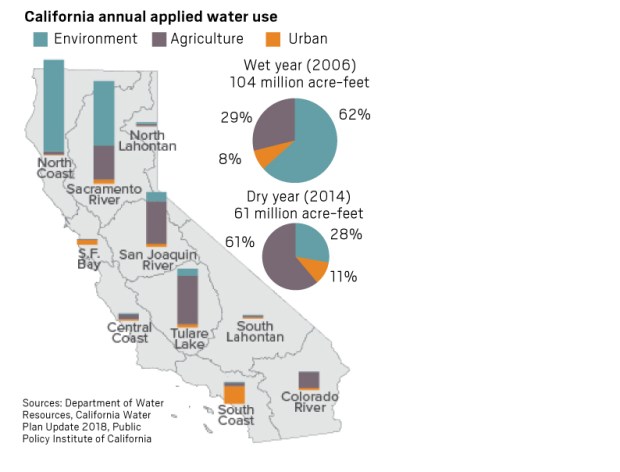As California is increasing restrictions on water usage, it may not feel like it, but drought here is less severe than many places around the world.
A look at the United Nations 2022 global drought-vulnerability index
Some drought impacts around the world
More than 1.4 billion people were affected by drought between 2000 and 2019. Drought affects the second-highest number of people, after flooding. Africa suffered from drought more frequently than any other continent with 134 droughts, of which 70 occurred in East Africa.
As a result of the Australian millennium drought, total agricultural productivity fell by 18% from 2002 to 2010.
The burden of water collection – especially in dry lands – falls disproportionately on women (72%) and girls (9%), who, in some cases, spend as much as 40% of their calorific intake carrying water.
Some drought impacts on ecosystems
The percentage of plants affected by drought has more than doubled in the last 40 years, with about 12 million hectares of land lost each year due to drought and desertification.
One-third of global carbon dioxide emissions is offset by the carbon uptake of terrestrial ecosystems, yet their capacity to sequester carbon is highly sensitive to drought events.
The rapid increase in surface temperature correlates with declining biodiversity, including higher extinction rates14% of all wetlands critical for migratory species, as listed by wetlands conservation organization Ramsar, are located in drought-prone regions.
The mega drought in Australia contributed to mega fires in 2019 and 2020 that resulted in the most dramatic loss of habitat for threatened species in postcolonial history; about 3 billion animals were killed or displaced.
How dry is it?
Scientists at NASA’s Goddard Space Flight Center generate groundwater and soil moisture drought indicators each week. They are based on terrestrial water storage observations derived from GRACE-FO satellite data and integrated with other observations, using a sophisticated numerical model of land surface water and energy processes.
The drought indicators describe current wet or dry conditions, expressed as a percentile showing the probability of occurrence for that particular location and time of year. Lower values mean drier than normal, and higher values mean wetter than normal.
Water restrictions coming
More than 4 million people in Southern California have been asked to suspend outdoor watering for 15 days, starting on Sept. 6 as officials work to fix a leak in a 36-mile section of the Colorado River aqueduct.
The restriction will be for Los Angeles County residents and businesses in Beverly Hills, Burbank, Glendale, Long Beach, Pasadena and San Fernando, according to the Metropolitan Water District of Southern California. Some of those communities already are under mandatory water restrictions implemented June 1, which will stay in place.
The pipeline affected carries water from the Colorado River, which supplies 40 million people and irrigates more than 5 million acres of farmland. The leak was found earlier this year, and the water district made a temporary repair and began operating the pipeline at a reduced capacity. The shutdown in September is to implement a more permanent solution.
Water saving tips
IN THE HOUSE
Fill bathtub halfway or less
Filling up your bathtub halfway or less can save 17-25 gallons of water per person every bath.
Install aerators
Installing aerators can save 0.7 gallons per minute.
Recycle indoor water and irrigate your garden
Recycling indoor water to use outdoors can cut water use by 30%.
Turn off water when brushing teeth, shaving
By turning off the water when brushing teeth or shaving you can save 8 gallons of water per person per day.
Fix leaks
Fixing leaks inside and outside the home can save 27 to 90 gallons of water each day.
Install high-efficiency toilets
Installing high-efficiency toilets can save 6-35 gallons per day.
Take 5-minute showers
Keeping showers under 5 minutes can save 12.5 gallons per shower when using a water-efficient shower head.
Wash full loads of clothes and dishes
Wash full loads of clothes and dishes. Washer: Saves 15–45 gallons per load. Dishwasher: Saves 5–15 gallons per load.
AROUND THE YARD
Use waterwise plants
Check with your local water agency on the best plants for your area. It is best to use waterwise, California native plants when possible.
Reimagine your yard
Feed your vegetables and fruits water first because they feed you! Waterwise plants and shade trees use little or no water once established. Thirsty plants such as lawn and container plants are the lowest priority.
Use drought-resistant trees, plants
Using drought-resistant plants and trees can save 30-60 gallons per 1,000 square feet each time.
Adjust sprinkler heads & fix leaks
Saves 12-15 gallons each time you water and a leak about as small as the tip of a ballpoint pen can waste about 6,300 gallons of water per month.
Use a broom to clean outdoor areas
Using a broom to clean outdoor areas can save 6 gallons every minute.
Set mower blades to 3 inches
Setting mower blades to 3 inches encourages deeper roots and saves 16-50 gallons per day.
Use mulch
Using mulch can save 20-30 gallons of water per 1,000 square feet each time you water.
Install drip irrigation and add a smart controller
Installing a drip irrigation system and a smart controller can save 15 gallons each time you water.
Sources: Environmental Protection Agency, saveourwater.com, The Associated Press, United Nations, NASA, Metropolitan Water District of Southern California, Department of Water Resources, California Water Plan Update 2018, Public Policy Institute of California




